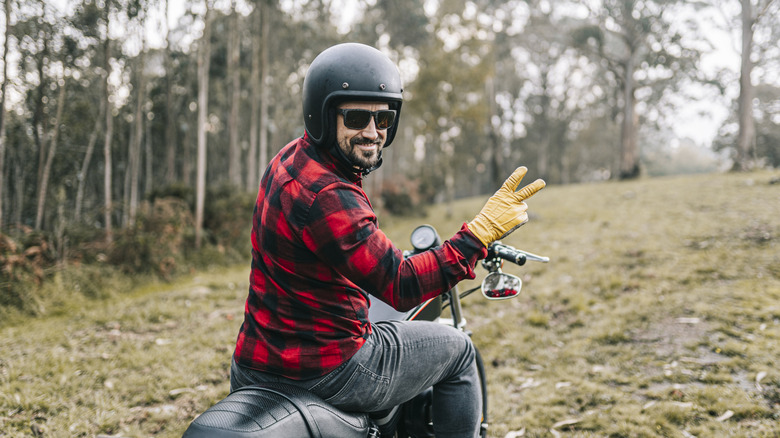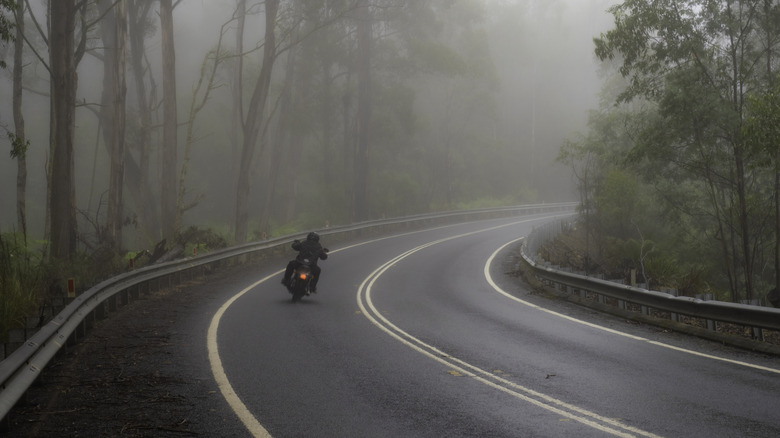What It Means When A Motorcyclist Flashes You The Peace Sign
For people who ride motorcycles, it can sometimes feel like the world is against you. Whether it's the unforgiving heat, slippery winter roads, or even just being around drivers who seem like it's their first time on the road, you're always fighting for your right to exist on what are supposedly common spaces. When you come across another motorcycle rider, it can feel like a breath of fresh air. So, how do you let them know that you're happy to have them around?
Riding a motorcycle requires a lot more mindfulness than driving a car, especially because you need to constantly balance yourself and keep your finger on the throttle. While we can all appreciate a great-sounding motorcycle, the reality is that it can be difficult to hear each other over their roar. Plus, you may be using ear protection in an effort to avoid unnecessary hearing-related issues in the future. Because of these limitations, motorcycle riders have developed quick and easy ways to express themselves with just their hands. There are many motorcycle hand signals, including the "motorcycle wave," low hand wave, and the peace sign, which is often used to give respect to a rider heading in the opposite direction from you. It is typically done with two fingers (index and middle) pointed to the ground at around a 45-degree angle. But, how did it start, when is it expected, and is it the only way you can give your regards?
How the peace sign became a motorcycle greeting
Before actions become traditions, many things simply begin as trends. Long before the age of social media and fast-paced algorithms, trends were often seeded through word-of-mouth or real-life observation of influential or well-respected people. So while no one really knows who popularized the motorcycle peace sign, one guess is that it came from the men behind the iconic Harley-Davidson brand. Motorcycle apparel company Saint shared how one theory is that Arthur Davidson and William Harley used to do it, and the act caught on. Since then, it has been adopted by biking cultures all over the world.
That said, the motorcycle wave is merely a suggestion and not a law on the road. In general, it's not expected when road conditions aren't that favorable, like when you're in the middle of a rain storm or on a treacherous path. Since safety is your priority, people will understand if you're too busy to acknowledge them.
While this particular sign doesn't really require any response on your part, it's important to recognize that other motorcycle hand signals are a little more urgent in nature. It's best to know some of the common motorcycle hand signals out there.
How to show love to other motorcycle riders
Apart from the peace sign, motorcycle groups all over the world have developed a few other ways to greet kindred spirits on the road. Outside America, it's more common for motorcycle riders to greet other riders with a side nod instead. This is a pretty good alternative if you're not comfortable taking your hands off the handle, even for a moment. In some cases, people also tend to give a thumbs up, which can work even when you're just standing on the side of the road as well.
That said, not all riders knows about this wave. Not everyone rides as part of a group, so there may not be anyone to pass on the traditions to them. For this reason, you shouldn't take it personally when someone doesn't reciprocate. To help do your part in keeping this tradition alive, consider sharing it as a fun fact at gatherings. And you could always try to wave the normal way to acknowledge a fellow rider. Greetings aside, some gestures play a bigger role than simply being polite. There are even signs that indicate that a motorcycle rider is in distress, such as someone leaving their helmet on the ground.


